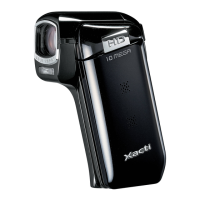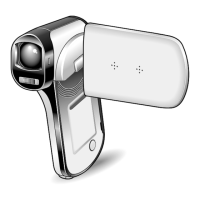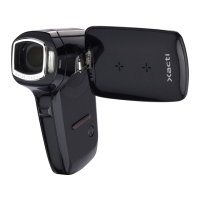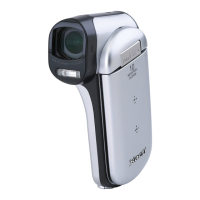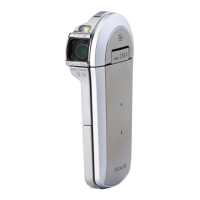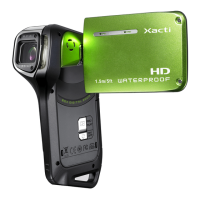- 5 -
5. Video Clip Recording and Playback
5-1. Recording
The signal from the camera block is input to IC101 (ASIC).
The data that is input to the ASIC is input to SDRAM, and
converts this data to encoded MPEG4 data, after which it is
written in sequence onto the SD card as streaming data. At
this time, the audio signals that are input to the built-in micro-
phone are converted into digital data by the audio CODEC IC
of IC182, and they are then input to ASIC. The audio data is
then encoded (AAC), and then it is written in sequence onto
the SD card together as streaming data with the image sig-
nals described above.
5-2. Playback
The data is read from the SD card, and the encoded data is
decoded into image data where it is displayed by the LCD or
on a TV monitor. At the same time, the audio data is also de-
coded, and is input to IC182 as digital data. D/A conversion is
carried out at IC182, and the sound is then output to the
speaker or to the LINE OUT terminal or the headphone.
6. Audio CODEC Circuit (IC182)
The audio signals from the microphone are converted into 16-
bit digital data. AD conversion is carried out at a maximum
sampling frequency of 48 kHz.
During audio playback, the 16-bit digital data is converted into
analog signals and these drive headphone through the speaker
or line out system and headphone amplifier. DA conversion is
carried out at a maximum sampling frequency of 48 kHz.
4. Lens drive block
4-1. Focus drive
The 16-bit serial data signals (LENS_SDI) and (LENS_SCLK
and LENS_EN) which are output from the ASIC (IC101) are
used to drive (FOCUS A +, FOCUS A -, FOCUS B + and FO-
CUS B -) by the motor driver IC (IC951), and are then used to
microstep-drive the stepping motor for focusing operation.
Detection of the standard focusing positions is carried out by
the ASIC detecting the signal (FOCUS_PI_E) from the
photointerruptor inside the lens block.
4-2. Zoom drive
The 16-bit serial data signals (LENS_SDI) and (LENS_SCLK
and LENS_EN) which are output from the ASIC (IC101) are
used to drive (ZOOM A +, ZOOM A -, ZOOM B + and ZOOM B
-) by the motor driver IC (IC951), and are then used to
microstep-drive the stepping motor for zooming operation.
Detection of the standard zooming positions is carried out by
the ASIC detecting the signal (ZOOM_PI_E) from the
photointerruptor inside the lens block.
4-3. ND filter
The 16-bit serial data signals (LENS_SDI) and (LENS_SCLK
and LENS_EN) which are output from the ASIC (IC101) are
used to drive (ND+ and ND-) by the motor driver IC (IC951),
and then the ND filter is inserted into and removed from the
beam path.
4-4. Iris drive
The drive method is a galvanometer type without braking coil.
The output from the Hall sensor inside the lens is amplified
by the Hall amplifier circuit inside the IC971 lens drive IC,
and the difference between the current and target aperture
determined by the resulting output and the exposure amout
output from the ASIC (IC101) is input to the servo amplifier
circuit (IC971) to keep the aperture automatically controlled
to the target aperture. The lens aperture control signal is out-
put from IC971 and is input to lens drive IN56 of IC951. IC951
functions as the driver for driving the lens.
4-5. Shutter drive
This is carried out by applying reverse voltages to the aperture
driving coil. When the shutter operates, the OC_EN
and OC_CONT signals are maintained at a high level, it is
input to IN56 of IC951 with low level.
At the same time the SHUTTER + signal that is output from
the ASIC (IC101) becomes high (input to STATE3 of IC951)
and the shutter operates. IC951 functions as the driver for
driving the lens.

